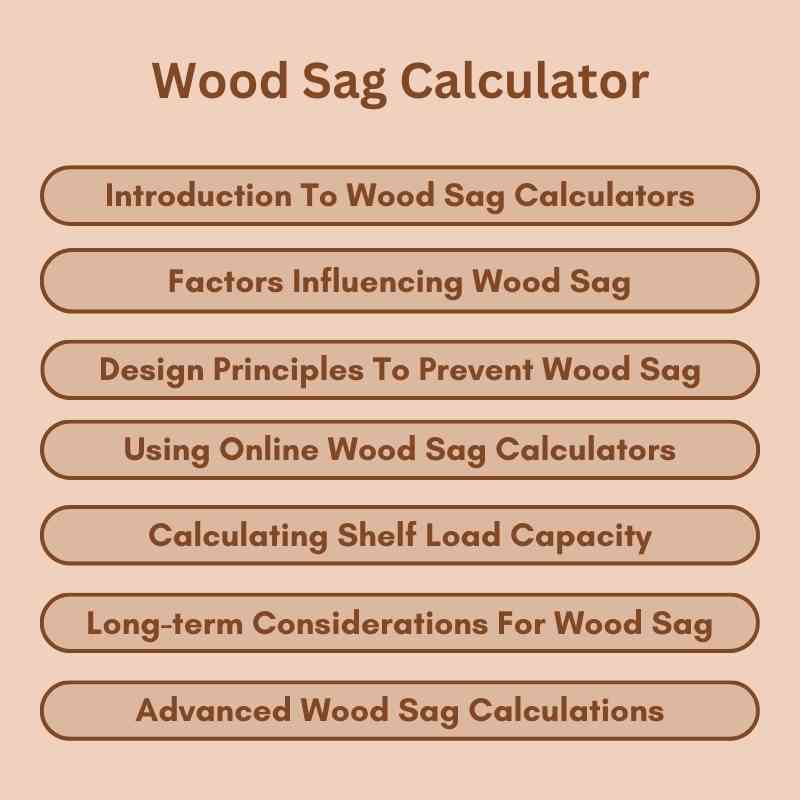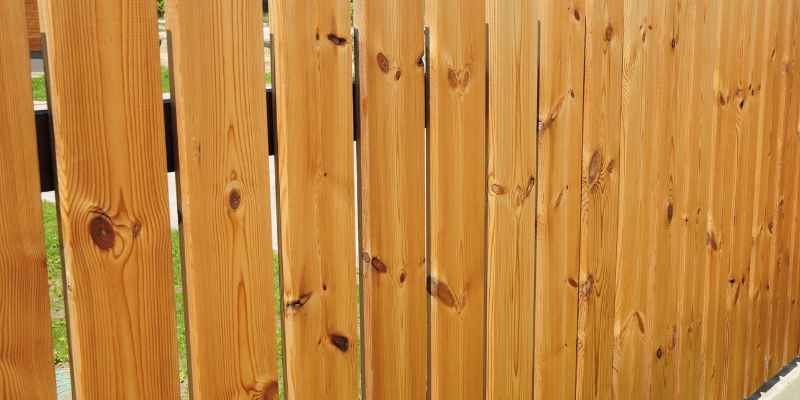To calculate wood sag, use a sag calculator to determine the deflection of a specific wood type and dimensions. By inputting the wood type, thickness, width, and length, the calculator will provide the sag measurement.
Understanding wood sag is crucial for designing shelves, tables, and other wooden structures to ensure they can support the intended load without bending or deforming over time. Wood sag can impact the functionality and aesthetics of furniture and shelving. By using a sag calculator, individuals can make informed decisions about the type of wood and dimensions needed to prevent sagging.
This proactive approach helps in creating durable and visually appealing wooden pieces that can withstand the test of time.
Introduction To Wood Sag Calculators
Wood sag calculators are essential tools for measuring the deflection in wooden structures. They are crucial for ensuring the structural integrity of various wooden applications. By accurately measuring sag, these calculators help in determining the appropriate thickness and length of wood to prevent sagging in shelves, tables, and other furniture.
Additionally, wood sag calculators play a vital role in selecting the most suitable types of wood for specific projects to ensure long-term durability and stability. Engineers and woodworkers rely on these calculators to make informed decisions about the materials and dimensions needed to prevent sag and maintain the strength of wooden structures. Furthermore, they are widely used in the woodworking industry to ensure the longevity and safety of wooden constructions.

Factors Influencing Wood Sag
Wood species and their properties: The type of wood used plays a significant role in determining its sag resistance. Quality solid hardwoods like cherry, oak, elm, walnut, and maple are known for their strength, density, longevity, and resistance to sagging.
Load types and weight distribution: The weight distribution and the type of load applied to the wood also affect its sagging potential. Uneven weight distribution or excessive loads can lead to increased sagging over time.
Proper shelf design guidelines: To prevent sagging, it is important to follow proper shelf design guidelines. Factors such as the thickness and length of the shelf, as well as the materials used for support, should be carefully considered.
Using the Sagulator: The Sagulator is an online calculator that can help determine the amount of sag expected in a wood shelf based on various inputs such as wood type, dimensions, and load. It can be a valuable tool in designing and assessing the sag potential of wooden structures.
Regular maintenance: Regular maintenance, such as checking for signs of sagging and reinforcing weak areas, can help prevent excessive wood sag over time. Ensuring proper support and addressing any issues promptly can extend the lifespan of wooden structures.
Choosing The Right Wood For Your Project
When selecting wood for your project, it’s crucial to consider sag resistance. Opt for hardwoods such as cherry, oak, elm, walnut, and maple due to their excellent strength, density, sag-resistance, longevity, and beauty. These woods are known to withstand sagging and are ideal for shelves and bookshelves. Hardwood plywood is also a great choice for minimizing sag, especially for wide shelves. By choosing the right wood, you can ensure your project maintains its structural integrity over time.
Design Principles To Prevent Wood Sag
When designing shelves, preventing wood sag is a crucial factor to consider. Optimal shelf dimensions and support placement strategies play a significant role in preventing wood sag. The length of a shelf is a crucial factor in determining its strength and resistance to sagging. It is recommended to use quality solid hardwoods such as cherry, oak, elm, walnut, and maple, which are known for their density, strength, sag-resistance, longevity, and beauty.
Apart from selecting the right wood, it is essential to ensure that the shelf’s thickness and length are appropriate to prevent sagging. Using an online calculator like Sagulator can help determine the ideal thickness and length of a shelf to prevent sagging. Moreover, proper support placement strategies, such as using brackets or bookends, can help distribute weight evenly across the shelf, preventing sagging.
Using Online Wood Sag Calculators
Online wood sag calculators can be incredibly helpful when designing and building shelves or other furniture pieces. The process is simple and straightforward, and can be broken down into a few easy steps.
- First, input the dimensions of the shelf or furniture piece you’re building.
- Next, select the type of wood you plan to use.
- The calculator will then generate a result, usually in the form of an estimated sag measurement.
Interpreting the results is important in order to ensure the structural integrity of your project. If the sag measurement is too high, you may need to adjust the thickness or length of your wood pieces. It’s also important to note that not all types of wood are created equal when it comes to sag resistance. Hardwoods like cherry, oak, elm, walnut, and maple tend to provide better strength, density, and longevity than softer woods.
Calculating Shelf Load Capacity
|
When it comes to calculating shelf load capacity, understanding shelf span is crucial. The length of a shelf can greatly affect its weight capacity. The longer the span, the more likely the shelf is to sag. To maximize weight capacity, it’s important to choose the right type of wood. Quality solid hardwoods like cherry, oak, elm, walnut, and maple provide excellent strength, density, sag-resistance, longevity, and beauty. To calculate shelf sag, you can use an online tool like the Sagulator. This calculator determines the thickness and length required to prevent shelves from sagging. It’s important to note that the weight distribution on the shelf also plays a role in determining its weight capacity. Overall, calculating shelf load capacity involves understanding shelf span, choosing the right wood, and using a tool like the Sagulator to determine required thickness and length. With these factors in mind, you can ensure that your shelves can support the weight of your items without sagging. |
Long-term Considerations For Wood Sag
Long-term considerations for wood sag are crucial for ensuring the longevity and durability of any wooden structure. One of the main factors that affect wood sag is humidity and temperature. As wood absorbs moisture, it expands and becomes more pliable, which can lead to sagging over time. Similarly, high temperatures can cause wood to dry out and shrink, resulting in sagging or warping.
To prevent wood sag, it’s essential to maintain proper humidity levels and temperature control. This can be achieved through regular inspections and maintenance, including sealing and staining the wood to protect it from moisture and temperature fluctuations. Additionally, using high-quality, dense hardwoods like cherry, oak, elm, walnut, and maple can provide excellent sag-resistance, strength, and longevity.
Advanced Wood Sag Calculations
When it comes to advanced wood sag calculations, it’s important to incorporate beam and suspension sag. Using calculators for complex structures can help in determining the appropriate materials and dimensions for your project. Wood sag can be a concern, but with the right calculations, you can ensure the strength and durability of your construction.
By utilizing online tools such as the Sagulator, you can accurately calculate shelf sag and determine the ideal wood types for your specific needs. Additionally, these calculators can also assist in determining the appropriate thickness and length of wood to prevent sagging. With the help of these tools, you can confidently design and build your wooden structures with minimal sagging and maximum stability.

Frequently Asked Questions
How Do You Calculate Sag?
To calculate SAG, you can use an online calculator like the Sagulator. This tool helps determine the deflection of wood shelves based on various factors such as wood type, thickness, and length. By inputting the necessary information, you can ensure that your shelves will not sag over time.
How Long Can A Shelf Be Before It Sags?
A shelf can start to sag if it’s longer than 24 inches, depending on the type of wood and load. To prevent sagging, use stronger wood or add support.
Does Wood Sag Over Time?
Wood may sag over time due to factors such as the weight of the load and the type of wood used. Quality solid hardwoods like cherry, oak, elm, walnut, and maple are less likely to sag and provide strength, density, and longevity.
To prevent sagging, it’s important to calculate the appropriate thickness and length of the wood.
What Wood Won’t Sag?
Certain solid hardwoods like cherry, oak, elm, walnut, and maple are known for their strength, density, and resistance to sagging. These woods provide excellent longevity and beauty, making them a good choice for preventing sagging in shelves or other applications.
Conclusion
Calculating wood sag is crucial when designing shelves and furniture to ensure their stability and longevity. By using tools like the Sagulator, you can determine the appropriate thickness and length of wood needed to prevent sagging. Opting for quality solid hardwoods like cherry, oak, elm, walnut, and maple can provide excellent strength, density, sag-resistance, and beauty.
So, next time you’re planning a woodworking project, make sure to consider wood sag calculations for a sturdy and durable result.

